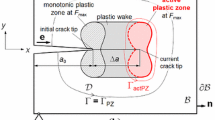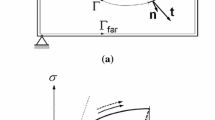Abstract
The definition of the cyclic J-integral is offered and its physical significance for fatigue crack growth is discussed using the Dugdale model on the assumption that the crack closure, cycle dependent creep deformation, and crack extension under cycling can be neglected. It is shown that the cyclic J-integral for small scale yielding is equivalent to theJ-integral for linear elastic crack independent of loading processes, while the value for large scale yielding varies with the loading processes. However, in both cases, the cyclicJ-integral remains constant during the reversal of loading under a constant stress range, if the first monotonic loading stage is excluded. In this situation, the cyclicJ-integral can be applied as a criterion for fatigue crack growth, since it is evaluated as a generalized force on dislocations to be moved or the energy flow rate to be dissipated to heat by the dislocation movements in an element just attached to the fatigued crack tip during one cycle of loading. It is suggested that the available experimental data of different materials for fatigue crack growth can be generalized to a unified formulation on the basis of the energy criterion. It is also deduced that the threshold ΔJ corresponding to ΔK th should be larger than 4γ where γ is the surface energy of the material. Finally the operational definition of the cyclicJ-integral on single loadversus displacement curves is given for center cracked plate with wide uncracked ligaments in tension.
Résumé
On présente la définition de l'intégrale J cyclique et sa signification physique dans le cas d'une croissance de fissure de fatigue est discutée en utilisant le modèle de Dugdale et l'hypothèse que la fermeture de la fissure, la déformation de fluage liée au cycle, et l'extension de la fissure au cours du cycle peuvent être négligées. On montre que l'intégraleJ cyclique est, dans le cas d'écoulement plastique à faible échelle, équivalente à l'intégraleJ utilisée pour les fissures élastiques linéaires indépendamment des processus de mise en charge, tandis que la valeur de déformation plastique macroscopique varie avec le processus de mise en charge. Cependant, dans les 2 cas, l'intégraleJ cyclique demeure constante au cours du renversement de charge appliquée à tension constante si l'on exclut le premier stade de mise en charge monotone. Dans cette situation, l'intégraleJ cyclique peut être appliquée comme critère de la croissance d'une fissure de fatigue puisqu'elle représente une forme généralisée de force, un effort sur les dislocations à mouvoir ou à l'écoulement d'énergie dissipée en chaleur par les mouvements de dislocation dans un élément immédiatement solidaire de l'extrémité de la fissure de fatigue, au cours d'un cycle de mise en charge. On suggère que les données expérimentales disponibles sur différents matériaux pour la croissance d'une fissure de fatigue puissent être généralisées à une formulation unifiée, sur base d'un critère d'énergie. On déduit également que le seuil ΔJ correspondant à ΔK th devrait être plus grand que 4γ, où γ est l'énergie de surface du matériau. Finalement, la définition opérationnelle de l'intégraleJ cyclique sous simple charge en fonction des courbes de déplacement est fournie dans le cas d'une plaque comportant une fissure centrale et de larges ligaments non fissurés, soumises à traction.
Similar content being viewed by others
References
J.R. Rice,Fracture, edited by H. Liebowitz, Academic Press, New York and London, Vol. 2 (1968) 191–311.
J.A. Begley and J.D. Landes, in ASTM STP 514 (1972) 1–20.
K.B. Broberg,Journal of Mechanical Physical Solids 19 (1971) 407–418.
N.E. Dowling and J.A. Begley, in ASTM STP 590 (1976) 82–103.
M.H. El Haddad, N.E. Dowling, T.H. Topper and K.N. Smith,International Journal of Fracture 16 (1980) 1530.
H. Kobayashi, H. Nakamura and H. Nakazawa, 3rd International Conference on Mechanical Behaviour of Materials, Cambridge, England, 3 (1979) 529–538.
J.R. Rice, in ASTM STP 415 (1967) 242–311.
J.N. Goodier and F.A. Field,Fracture of Solids, edited by D.C. Drucker and J.J. Gilman, John Wiley, New York (1963) 103–118.
T. Mura, inIUTAM Symposium on High Velocity Deformation of Solids, edited by K. Kawai, Springer (1979) 295–304.
J. Weertman, Proceedings, International Conference on Fracture, Sendai, Japan (1965).
B. Budiansky and J.W. Hutchinson,Journal of Applied Mechanics 45 (1978) 267–276.
R.C. Bates and W.G. Clark, Jr.,Transactions ASM 62 (1968) 380.
K. Tanaka, C. Masuda and S. Nishijima,Scripta Metallurgica 15 (1981) 259–264.
A.S. Tetelman and A.J. McEvily, Jr.,Fracture of Structural Materials, John Wiley and Sons, New York (1967).
L.M. Pook, in ASTM STP 513 (1972) 106–124.
K. Jerram and E.K. Priddle,Journal Mechanical Engineering Science 15 (1973) 1061–1071.
R.J. Cooke and C.J. Beevers,Materials Science Engineering 13 (1974) 201–210.
R.J. Cooke, P.E. Irving, G.S. Booth and C.J. Beevers,Engineering Fracture Mechanics 7 (1975) 69–77.
C.J. Beevers, R.J. Cooke, J.F. Knott and R.O. Ritchie,Metal Science 9 (1975) 119.
J. Masounave and J.-P. Bailon,Scripta Metallurgica 9 (1975) 723–730.
J. Mautz and V. Weiss, in ASTM STP 601 (1976) 154–168.
R.O. Ritchie,Metal Science 11 (1977) 368–381.
E. Sasaki, A. Ohta and M. Kosuge,Transactions of National Research Institute for Metals 19 (1977) 183–199.
O. Vosikovsky,Journal of Testing and Evaluation 6 (1978) 175–182.
E.K. Priddle,Scripta Metallurgica 12 (1978) 49–56.
T.L. Mackey,Engineering Fracture Mechanics 11 (1979) 753.
S. Usami, in Fatigue Thresholds,Proceedings of the International Conference, Stockholm, edited by J. Backlund, A.F. Blom and C.J. Beevers, Engineering Materials Advisory Service (1981).
K. Sumita, N. Maruyama and I. Uchiyama,Tetsu-to-Hagane (in Japanese) 68 (1982) 451–460.
S. Matsuoka, private communication.
A. Kelly,Strong Solids, The Clarendon Press, Oxford (1966).
K. Tanaka,International Journal of Fracture 139 (1977) 563–583.
J.R. Rice, P.C. Paris and J.G. Merkle, in ASTM STP 536 (1973) 231–244.
C.F. Shih and J.W. Hutchinson,Journal of Engineering Materials and Technology 98 (1976) 289–295.
G.T. Hahn and A.R. Rosenfield,Acta Metallurgica 13 (1965) 293–306.
Author information
Authors and Affiliations
Rights and permissions
About this article
Cite this article
Tanaka, K. The cyclicJ-integral as a criterion for fatigue crack growth. Int J Fract 22, 91–104 (1983). https://doi.org/10.1007/BF00942715
Received:
Revised:
Issue Date:
DOI: https://doi.org/10.1007/BF00942715




